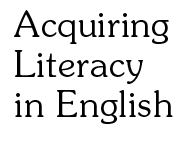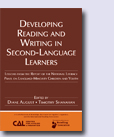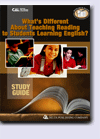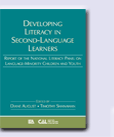Acquiring Literacy in English: Crosslinguistic, Intralinguistic, and Developmental Factors
Overview
Acquiring Literacy in English (ALE) was a 5-year program of research in which the Center for Applied Linguistics and its collaborators, Harvard University, Johns Hopkins University, the University of Miami, and the University of Houston, studied the factors that predict success as Spanish-speaking children learn to read and write in English. While literacy in monolingual English-speaking children has been intensively studied, much less is known about how the process of acquiring literacy differs for monolingual and bilingual children. For example, does literacy in one language facilitate or hinder the acquisition of literacy in a second language? If literacy skills acquired in one language can be transferred to the development of literacy in another language, may all such skills be transferred? What are the conditions that favor transfer?
ALE was one component of a larger research initiative, Development of Literacy in Spanish Speakers (DeLSS) that was jointly organized and funded by the National Institute of Child Health and Human Development (NICHD) and the Institute of Education Sciences of the Department of Education. The grant period ran from 2000 to 2005.
Study Components and Subjects
ALE was composed of three subprojects and a research and assessment core. Taken together, these components describe English literacy development for Spanish speakers in a variety of social and educational contexts. Groups of children studied during the course of the research ranged from pre-kindergarten age to fifth graders. They were attending schools in widely scattered locations, including Chicago, Boston, New York, Philadelphia, Washington, Miami, El Paso, Albuquerque, Los Angeles, Puerto Rico, and Mexico.
Factors Under Investigation
Investigators studied environmental factors that might affect the ease or difficulty of learning to read, with special focus on the instructional environment. Some of the children in the study were Spanish speakers who were taught to read first in Spanish and later transitioned to reading in English. Others were Spanish speakers for whom the learning of reading skills began with instruction in English reading. For comparison, the investigators also studied monolingual English speakers learning to read in English and monolingual Spanish speakers learning to read in Spanish.
The home environment may also affect a child's acquisition of English literacy. Investigators therefore examined factors such as patterns of use of English and Spanish in the home and parents' attitudes toward schooling and the development of literacy skills.
Investigators took particular interest in learning how skills that are acquired earlier in the process of learning to read may undergird the development of more demanding and sophisticated skills. Another important focus was how skills that are acquired when learning to read in Spanish can transfer to the development of reading skills in English.
Acquiring Literacy in English Subprojects
Please follow the links below for information about the three individual subprojects and the Research and Assessment Core of Acquiring Literacy in English.
Subproject 1:
Early Childhood Study of Language and Literacy Development of Spanish-Speaking Children
Subproject 2:
Transfer of Reading Skills in Bilingual Children
Subproject 3:
Spelling as an Indicator of English Literacy Development
Research and Assessment Core
Publications resulting from the studies
Assessment instruments developed for the studies





